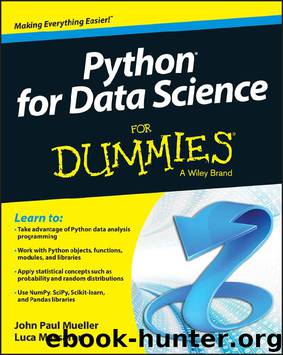Python for Data Science For Dummies by Luca Massaron & John Paul Mueller

Author:Luca Massaron & John Paul Mueller [Luca Massaron]
Language: eng
Format: epub
Tags: Python
Publisher: For Dummies
Published: 2015-07-06T21:00:00+00:00
Stretching Python’s Capabilities
In This Chapter
Understanding how Scikit-learn works with classes
Using sparse matrices and the hashing trick
Testing performances and memory consumption
Saving time with multicore algorithms
If you’ve gone through the previous chapters, by this point you’ve dealt with all the basic data loading and manipulation methods offered by Python. Now it’s time to start using some more complex instruments for data wrangling (or munging) and for machine learning. The final step of most data science projects is to build a data tool able to automatically summarize, predict, and recommend directly from your data.
Before taking that final step, you still have to massage your data by enforcing transformations that are even more radical. That’s the data wrangling or data munging part, where sophisticated transformations are followed by visual and statistical explorations, and then again by further transformations. In the following sections, you learn how to handle huge streams of text, explore the basic characteristics of a dataset, optimize the speed of your experiments, compress data and create new synthetic features, generate new groups and classifications, and detect unexpected or exceptional cases that may cause your project to go wrong.
From here onward, you use the Scikit-learn package more and more (which means knowing more about it — the full documentation appears at http://scikit-learn.org/stable/documentation.html). The Scikit-learn package, in fact, offers a single repository containing almost all the tools that you need to be a data scientist and for your data science project to be successful. In this chapter, you discover important characteristics of Scikit-learn, structured in modules, classes, and functions, and some advanced Python time savers for improving performance with big unstructured data and highly time-consuming computational operations.
You don’t have to type the source code for this chapter in by hand. In fact, it’s a lot easier if you use the downloadable source (see the Introduction for download instructions). The source code for this chapter appears in the P4DS4D; 12; Stretching Pythons Capabilities.ipynb source code file.
Download
This site does not store any files on its server. We only index and link to content provided by other sites. Please contact the content providers to delete copyright contents if any and email us, we'll remove relevant links or contents immediately.
Hello! Python by Anthony Briggs(10200)
The Mikado Method by Ola Ellnestam Daniel Brolund(10108)
OCA Java SE 8 Programmer I Certification Guide by Mala Gupta(10044)
Algorithms of the Intelligent Web by Haralambos Marmanis;Dmitry Babenko(8589)
Sass and Compass in Action by Wynn Netherland Nathan Weizenbaum Chris Eppstein Brandon Mathis(7969)
Grails in Action by Glen Smith Peter Ledbrook(7942)
Test-Driven iOS Development with Swift 4 by Dominik Hauser(7900)
The Well-Grounded Java Developer by Benjamin J. Evans Martijn Verburg(7843)
Windows APT Warfare by Sheng-Hao Ma(7674)
Layered Design for Ruby on Rails Applications by Vladimir Dementyev(7407)
Blueprints Visual Scripting for Unreal Engine 5 - Third Edition by Marcos Romero & Brenden Sewell(7306)
Secrets of the JavaScript Ninja by John Resig Bear Bibeault(6740)
Kotlin in Action by Dmitry Jemerov(5369)
Solidity Programming Essentials by Ritesh Modi(4476)
Hands-On Full-Stack Web Development with GraphQL and React by Sebastian Grebe(4403)
WordPress Plugin Development Cookbook by Yannick Lefebvre(4286)
Unity 3D Game Development by Anthony Davis & Travis Baptiste & Russell Craig & Ryan Stunkel(4197)
Functional Programming in JavaScript by Mantyla Dan(4171)
The Ultimate iOS Interview Playbook by Avi Tsadok(4167)
